Category Archive: Legislation
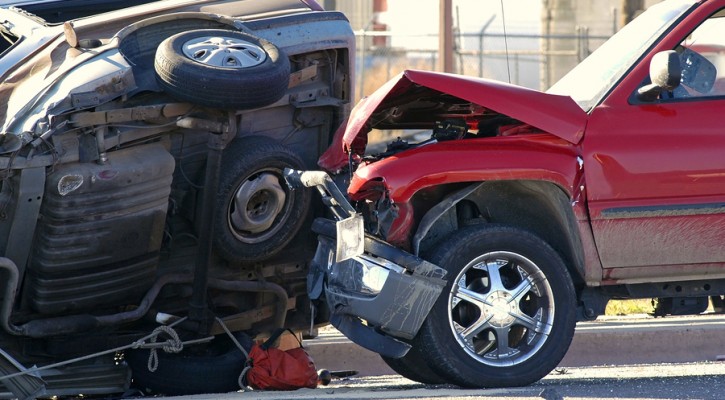
Collision Avoidance Systems Should Be Standard Equipment On All Vehicles: NTSB
June 12, 2015
Collision avoidance systems should be standard equipment on all new vehicles according to a new report issued by the National Transportation Safety Board (NTSB). The NTSB is the federal agency whose job is to investigate transportation crashes of all types; aircraft, train, ship, bus, or truck. The report came about as a result of the investigation of just nine rear end motor vehicle crashes involving 48 vehicles that resulted in 28 deaths and 90 injuries.
In the US, rear end crashes are the most common type of crash involving two or more vehicles. According to the NTSB report, rear end crashes make up almost half of all motor vehicle crashes involving two or more vehicles. In the years 2011 and 2012, rear end crashes resulted in the deaths of 3,491 people and more than a million injuries. In 2012 alone, there were more than 1.7 million rear end crashes.
There are several reasons for rear end collisions including; driver distraction, false expectations of of driver intent, unsafe speed, and fatigue. However, the most common reason, according to the National Highway Transportation Safety Administration (NHTSA) is driver distraction. According to NHTSA, 87 percent of rear end crashes are due to driver distraction.
Several different types of collision prevention systems have been available over the past 20 years including;
- Collision warning systems (CWS) that alerted a driver to the possibility of a collision.
- Adaptive cruise control (ACC) that automatically maintains a safe following distance between vehicles ahead.
Both the CWS and ACC systems are passive systems that still required the driver to take action to avoid a rear end crash but the driver may not react in time.
The latest version, known as the collision avoidance system (CAS) combines the CWS and ACC into an active system that takes control of the vehicle to avoid a crash. If the CAS system senses a probable crash, it will automatically apply the brakes in time to avoid the crash. The CAS system can respond much faster than the human driver.
Using the data from the 2011 and 2012 crash database, the NTSB estimated that the use of a collision avoidance system could have saved up to 2,220 lives. They also estimated that injuries could have been avoided or reduced in 93.7 percent of those crashes.
Collision avoidance systems are already available in a few high end model cars. The NTSB is making the following recommendations regarding collision avoidance systems:
- For manufacturers to install forward collision avoidance systems as standard features on all newly manufactured passenger and commercial motor vehicles,
- For NHTSA to expand the New Car Assessment Program to include a graded rating to assess the performance of forward collision avoidance systems, and
- For NHTSA to expand or develop protocols for the assessment of forward collision avoidance systems in passenger and commercial vehicles.
Read more: Safety Shouldn’t Be a Luxury Feature

Bicycle Deaths – Florida Sets Another Record
May 18, 2015
When it comes to roadway safety, Florida has set another record – the highest rate of bicycle deaths in the nation. Florida’s lead in bicycle deaths follows another Florida record as the number one killer of pedestrians.
In terms of population, Florida is only the third largest state in the US after California and Texas so it would seem that those two states would have a much higher rate of bicycle deaths and in raw numbers, that may be true but when you compare populations, Florida has the highest rate of all.
Let’s look at how the numbers fall out.
|
State |
Population in millions |
Number of registered motor vehicles in millions |
Number of cyclists killed |
Rate of cyclists killed per million of population |
|
California |
38.8 |
33.55 |
141 |
3.68 |
|
Texas |
26.96 |
23.87 |
48 |
1.81 |
|
Florida |
19.89 |
19.64 |
133 |
6.8 |
Florida, with less than half of the population and just a little over half the number of registered vehicles of California, had just eight fewer bicycle deaths than California. When compared to the rate of bicycle deaths per million population, Florida beats every other state in the nation.
So, what’s Florida doing wrong? The League of American Bicyclists puts out a report card every year that rates states on their friendliness to cyclists. To rate states they look at;
- Legislation and enforcement;
- Policies and programs;
- Infrastructure and funding;
- Education and encouragement; and
- Evaluation and planning
In their latest ranking, the League rates California as the eighth friendliest state for cyclists while it rates Florida 24th. In all five categories, California ranks near the top while Florida’s rankings are near the bottom.
The two main areas that Florida needs to work on are:
- Vulnerable road user law – A law was proposed in the last session of the legislature that would have imposed higher penalties for any driver that passes or turns in front of a vulnerable road user (pedestrians, cyclists, animal riders, personal mobility devices) in an unsafe manner. The bill looked like a sure thing to pass however, in a dispute between the Florida Senate and the House, the bill failed to pass during this session.
- Complete Streets – Complete Streets are roadway projects designed with both cyclists and pedestrians in mind. When widening existing roads or proposing new roadways, Florida is falling short in planning and designing for Complete Streets.
Read More: The Deadliest States for Bikers
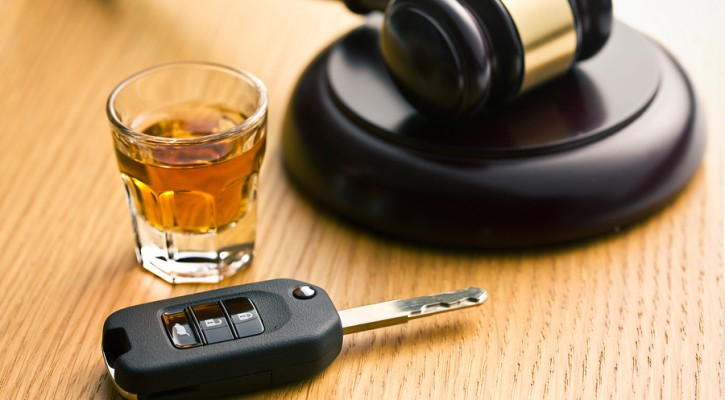
MADD Opposes Proposed Florida DUI Bills
March 25, 2015
Mothers Against Drunk Driving ( MADD ) has come out in opposition to two bills that are currently under consideration by the Florida legislature. The proposed bills, HB 1117 and SB 1192, if passed, would authorize Florida courts to order a transdermal monitoring device or treatment program in lieu of ignition interlock device for certain DUI offenders. MADD feels that these bills, if passed, would weaken rather than strengthen Florida’s DUI laws.
Last year, under the general transportation bill passed and signed by the governor, the Florida legislature gave judges the authority to require ignition interlock systems for certain, first time DUI offenders. Before passage of that bill, interlock devices could only be ordered for someone convicted of a second or subsequent DUI offense.
Ignition interlock devices, when installed in a DUI offender’s vehicle, require the driver to blow into a device that measures alcohol content. If alcohol is detected, the vehicle will not start.
Transdermal devices are worn by the offender either as a wrist or ankle bracelet and they determine whether or not the wearer has been drinking by measuring the alcohol content in their perspiration. If the presence of alcohol is detected, a signal is sent to law enforcement authorities or parole officers. For anyone who has been ordered by the court to completely abstain from the use of alcohol, the transdermal device is an effective tool for ensuring compliance with the court’s order.
MADD’s issue with the bills under question is that the only thing the transdermal device will do is notify authorities that the offender has been drinking; it won’t prevent the offender from driving a vehicle while drunk. If the transdermal device was the only device used, it would require an immediate response from the police or parole officers to find and prevent the offender from getting into a vehicle. That’s not very likely.
MADD feels that the transdermal device would be an effective tool along with an ignition interlock device but it should not be an either/or option for the Florida courts.
According to the Centers for Disease Control and Prevention (CDC), interlocks have been shown to reduce repeat offenses by 67 percent. States that have all-offender interlock laws in place have seen a reduction in drunk driving deaths of up to 45 percent. Currently, 24 laws have these laws already in place and MADD is pushing for laws in all 50 states to make ignition interlock devices mandatory for all first time DUI offenders.
If you agree with MADD that these bills should not be passed contact your Florida State representatives.
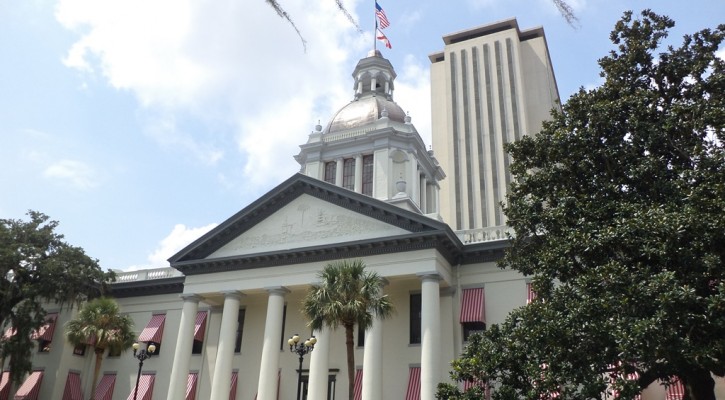
Traffic Safety Bills Considered By Florida Legislature
March 17, 2015
Several new traffic safety bills are being considered by the Florida legislature’s 2015 session currently underway in Tallahassee. Proposals for new laws and revisions of current traffic safety laws by both the senate and the house are making their way through various committees. These proposed traffic safety bills, if passed and signed into law, will have a significant impact on Florida drivers.
Texting while driving – The current law bans texting while driving but it is a secondary offense, meaning that a texting driver can only be issued a ticket for texting if he or she is seen texting while committing another primary offense such as speeding or running a red light.
HB1 Would remove the provision that makes texting a secondary offense making it a primary offense, meaning a driver can be stopped and ticketed for texting alone, and would enhance penalties for texting in a school zone or school crossing.
Cell Phones – Currently, there are no prohibitions on the use of cell phones while driving for any driver.
HB 17 Would prohibit the use of cellular telephones & other electronic communications devices by drivers in school zone or school crossing or on school district property.
HB 191 Would prohibit use of cellphones or any other type of mobile telecommunications device (wireless telephone, computer, or other electronic device used to access the facilities of a communications service) by drivers under the age of 18.
Vulnerable road users – Last year the legislature passed a law calling for higher penalties for drivers who injure or kill vulnerable road users (pedestrians, cyclists, motorcyclists, horseback riders).
Combined S/HB 231 Revises provisions relating to the rights & safety of vulnerable users of public rights-of-way; prohibits assault of bicycle riders; revises provisions for careless driving; provides penalties for specified infractions contributing to bodily injury of vulnerable users.
SB 908 Revises provisions relating to the passing of a vehicle; prohibiting passing and turning in front of a vulnerable user in an unsafe manner; prohibiting harassing, taunting, or throwing an object at a person riding a bicycle; providing criminal penalties; requiring traffic law and substance abuse education courses to include instruction on traffic laws relating to rights and safety of vulnerable users
SB 1376 Provides criminal penalties for a person who commits a moving violation that causes serious bodily injury to, or causes the death of, a vulnerable road user; requiring that the person pay a specified fine, serve a minimum period of house arrest, and attend a driver improvement course, etc.
Drinking and driving – Current law provides for harsher penalties for a second or subsequent DUI conviction within a 75 year period. Last year the legislature passed a law authorizing judges to require ignition interlock devices for first time DUI offenders.
HB-289 and SB 598 – Boating under the influence (BUI) Provides that conviction for BUI be recorded in person’s driving record; provides that convictions for BUI are considered prior convictions for DUI; provides that conviction for BUI be reported to DHSMV; provides that convictions for DUI are considered prior convictions for BUI.
HB 1117 and SB 1192 – Authorizes court to order transdermal monitoring device or treatment program in lieu of ignition interlock device.
School Buses – Current law in all 50 states require drivers to stop for school buses loading and unloading students.
HB 487 Known as “Gabby’s Law for School Bus Stop Safety”; revises penalties for failure to stop vehicle upon approaching school bus that displays stop signal.
Non-criminal traffic offenses – Non-criminal traffic offenses normally do not carry the threat of jail.
SB 1254 – Would provide criminal penalties for certain noncriminal traffic infractions that cause serious bodily injury or death to a person, etc.
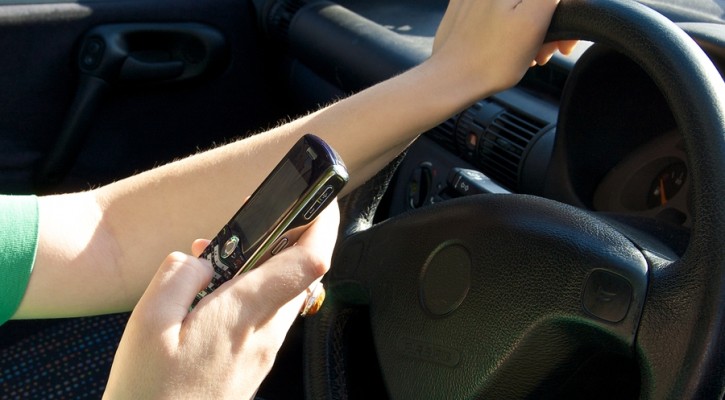
Proposed Bills To Ban Texting, Teen Cellphone Use in Florida
January 27, 2015
Two proposed bills by Florida lawmakers aim to further limit texting and cellphone use by Florida drivers. One bill seeks to make texting behind the wheel a primary offense. The other bill would prohibit the use of cell phones by drivers under the age of 18.
Texting Bill
One of the proposed bills sponsored by Rep. Ray Pilon, R-Sarasota and Rep. Richard Stark, D-Weston, would change Florida’s current anti-texting law from a secondary offense to a primary offense and would add enhanced penalties for those drivers caught texting in school zones or school crossing zones.
Florida’s current anti-texting bill is a “secondary offense” meaning that a law enforcement officer can only issue a ticket if he or she observes a driver texting while, at the same time, committing a “primary offense” such as speeding or running a red light. As a result, very few tickets have been issued for texting since the law went into effect.
Teen Cell Phone Ban
Another of the proposed bills sponsored by Sen. Anitere Flores, R-Miami, would prohibit the use of any type of “mobile telecommunications device” by drivers under the age of 18. Violation of this law would be considered a nonmoving offense.
Graduated Driving License Laws (GDL), are laws enacted in most states to gradually introduce teens to the driving environment. These laws are designed to give give teens more driving experience without distractions by limiting the number of passengers they can carry and by prohibiting the use of cell phones etc. Currently, 31 states prohibit use of cell phones by teen drivers. Fifteen more states place some sort of limitation on cell phone use by teens. Currently there are no limits on cell phone use by Florida drivers of any age.
Last week, the organization Advocates for Highway Safety, released a state-by-state report card based on state driving safety laws. Florida received a failing grade due to the lack of laws such as those proposed above. Even if these proposed bills were passed, Florida would still have less than half of the laws recommended by the Advocates and their passage would only move Florida from the “red zone” (the State falls dangerously behind in adoption of key safety laws) into the “yellow zone” (the State is advancing but has numerous gaps in its highway safety laws).
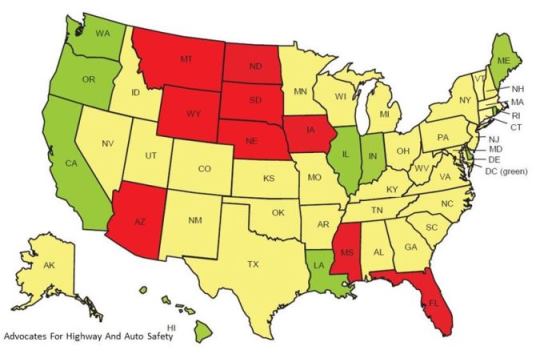
Florida Fails When It Comes To Safe Driving Laws
January 22, 2015
When it comes to safe driving laws, Florida ranks near the bottom compared with other states according to a report published today by Advocates for Highway and Auto Safety (Advocates). The report ranks states based on fifteen basic driving safety laws, giving points for each law a state has on its books.
The report used a three color grading system based on each state’s overall score. Grades given were:
- Green – State is significantly advanced toward adoption of all Advocates’ recommended highway safety laws.
- Yellow – State is advancing but has numerous gaps in its highway safety laws.
- Red – State falls dangerously behind in adoption of key safety laws.
Florida was one of nine states to receive a red score with only six out of the fifteen recommended safe driving laws enacted.
This year’s report stresses what the Advocates call “lethal loopholes” in laws that fail to protect drivers and passengers and contribute to preventable deaths and injuries. Lethal loopholes refer to laws that don’t go far enough to protect vehicle occupants or that are “secondary enforcement laws.” For those unfamiliar with secondary enforcement laws, we need to take a moment to explain how they work.
A good example of a secondary enforcement law in Florida is the new anti-texting law that took effect in October of 2013. The law, which prohibits drivers from writing, sending, or reading written communications on any wireless communications device, sounds like a good law at first glance however, the law is a secondary enforcement law. That means that a law enforcement officer can’t stop a driver and issue a ticket just for texting alone. The officer must first witness a driver texting while, at the same time, violating a primary enforcement law such as speeding or running a red light before stopping the driver and issuing a ticket. As a result, Florida’s anti-texting law is basically toothless and law enforcement agencies throughout the state report that they have issued very few tickets under this law.
When ranking states on whether or not they had one of the fifteen laws on the books, the Advocates didn’t count those laws that were secondary enforcement laws. They also didn’t give points to laws that didn’t go far enough to protect vehicle occupants from injury or death. In Florida’s case, those laws include:
- Florida’s newly enacted child booster seat law that only requires the use of booster seats for children under the age of five. Adult seat belts don’t fit children properly and the Insurance Institute for Highway Safety (IIHS) recommends that children remain in a booster seat until they are at least 4’9” tall. For the average child, that can be anywhere from 9 to 11 years of age. Effective booster seat laws require the use of a booster seat until the child is either 4’9” tall or 9 years of age.
- Florida’s seat belt law is a primary law for occupants of the front seat and anyone under the age of 18 no matter where they are seated. However, it doesn’t require the use of seat belts by back seat occupants over the age of 18.
- Graduated Driver License (GDL) laws are designed to give teen drivers more driving experience without distractions until they have more experience. Effective GDL laws restrict the number of passengers a teen can carry, limit night time driving, and the use of cell phones. Florida’s GDL laws have no restrictions on passengers or the use of cell phones by newly licensed teen drivers. In 2012, Florida came in at third place after Texas and California in the number of highway deaths involving teen drivers.
- Florida’s motorcycle helmet law allows riders over the age of 21 with at least $10,000 worth of medical insurance coverage to ride without a helmet. Florida, with only 47% of the riders using helmets, led the nation in motorcycle deaths in 2012.
For more information on how Florida’s safe driving laws scored, read: 12TH ANNUAL ROADMAP OF STATE HIGHWAY SAFETY LAWS
Image compliments of: Advocates for Highway and Auto Safety
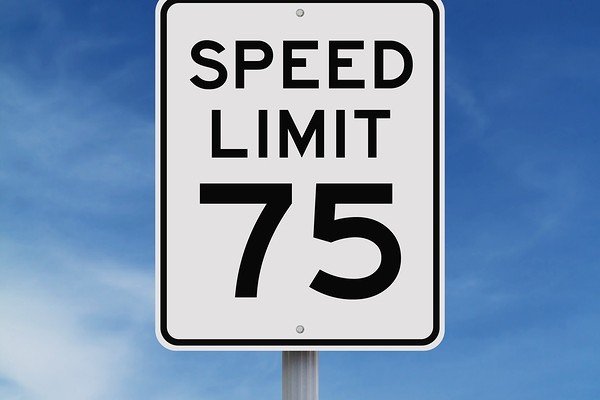
Legislators Seek To Raise Speed Limits
January 16, 2015
It’s that time of year again when state legislatures meet and bills to raise speed limits on interstates and state roads are introduced. Bills are being introduced in several states to raise the speed limit on interstates within the state’s borders up to 75 and even 80 mph. Apparently, the legislators who are pushing for these bills are pandering to constituents who want the speed limits raised without considering the danger posed by those speed limit increases.
In 2011, the State of Kansas increased speed limits to 75 mph on certain highways. According to Kansas Department of Transportation statistics, in the two years following the speed limit increase, the number of deaths on those Kansas highways where the speed limit was raised increased by 54 percent. Injury collisions also increased on those highways by 13 percent compared to the two years before the law change.
The Kansas statistics follow other studies that have found increases in the death rate after speed limits were raised. A 2009 study published in the American Journal of Public Health looked at the death rate on American highways after congress abolished the federal maximum speed limit in 1995. The study found an increase in the death rate of 3.2 percent on all roads, a 9.1 percent increase on rural interstates and a 4 percent increase on urban interstates. What that meant in real numbers were 12,545 deaths and 36,583 injuries that were directly attributed to the increase in speed limits.
In 2006, Iowa’s Department of Transportation conducted a study looking at the death rate in several mid-western states that had raised speed limits compared to states that didn’t. They found an overall fatality increase of nine percent in those states that raised the speed limit compared with a seven percent reduction in the states that hadn’t raised the speed limit.
Higher speed is a problem because it reduces a driver’s time to react to an emergency on the road. Higher speeds also make it more difficult to keep a car on the road on curves or when trying to avoid a crash. Higher speeds also increase the crash forces exponentially. When comparing a crash with a car hitting a stationary object at 70 mph vs the same crash at 75 mph, the difference between 70 and 75 mph represents an increase in speed of only seven percent but an increase of 14 percent in crash forces. According to figures from the National Highway Traffic Safety Administration (NHTSA), speed was responsible for approximately one-third of all highway deaths in 2012.
Some legislators maintain that increased speed limits allow goods to travel to markets faster, saving money and creating a business friendly environment. According to a May 2014 report by NHTSA, crashes involving a speeding vehicle traveling over the posted limit or too fast for conditions cost the nation $59 billion in 2010, an average of $191 for every person in the U.S.
In last year’s legislative session, the Florida legislature passed a bill that would have increased the speed limit on certain Florida highways to 75 mph but after protests from the Florida highway patrol, other law enforcement agencies, and safety experts, the governor vetoed the bill.

Drugged Driving Increasing But Hard To Prove
November 25, 2014
The increase in instances of drugged driving has law enforcement and state officials worried throughout the country. With more states either legalizing or decriminalizing marijuana use, police are seeing more instances of drivers under the influence of marijuana. The problem is that it’s hard to prove under many state laws. Continue Reading

Crashes Increase After Red Light Cameras Are Removed
November 24, 2014
A recent report by WBBH TV in Florida shows that crashes increased at intersections after red light cameras were removed. The Collier County, FL board of commissioners voted in 2013 to remove red light cameras saying there was no proof they made the streets safer. In their report, WBBC compared crash data during the 18 months after the cameras were removed to crash data for the 47 months the cameras were in use. The results showed that, on average, there were ten more crashes per month after the cameras were removed than when they were there. Continue Reading

A Single Statistic: Red Decals For Teen Drivers
November 17, 2014
Do red decals for teen drivers work to save lives? A recent study shows that understanding a single statistic can change the public’s attitude on the need for safe driving laws. With that in mind, we are posting a series of single statistics on a variety of traffic safety issues. Many lawmakers are reluctant to enact driving safety laws because they feel – rightly or wrongly – that the public doesn’t support such reforms. If your state legislature is debating a traffic safety issue, it’s hoped that this single statistic will provide the public with the knowledge needed to make informed decisions that they can then share with their representatives. Continue Reading
